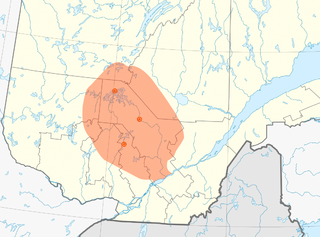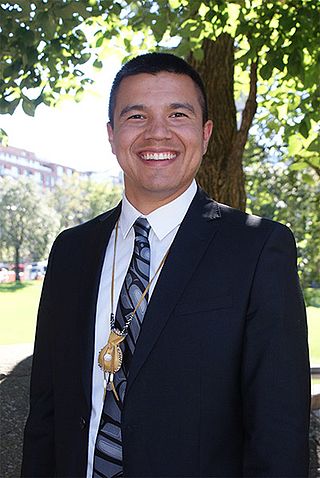
The Cree or nehinaw are a North American Indigenous people. They live primarily in Canada, where they form one of the country's largest First Nations. More than 350,000 Canadians are Cree or have Cree ancestry. The major proportion of Cree in Canada live north and west of Lake Superior, in Ontario, Manitoba, Saskatchewan, Alberta, and the Northwest Territories. About 27,000 live in Quebec.

Nitaskinan, also known as Nehirowisi Aski, is the ancestral country of the Atikamekw people. It is located in the valley of the Saint-Maurice River in Quebec, Canada. It covers an area of 80,000 km2 (31,000 sq mi). On 8 September 2014, the Conseil de la Nation Atikamekw declared unilaterally the sovereignty of the Atikamekw Nation on the Nistaskinan. The objective of this is mainly to obtain a right of review for the projects exploiting the natural resources and to highlight the Atikamekw's identity. "Nitaskinan" means "our (excl.) land" in the Atikamekw language, where "Kitaskinan" means "our (inclusive) land," similar to other Cree languages' use of aski. From a legal perspective, according to the Canadian Indian Act, the Atikamekw have self-administration on three Indian reserves, Manawan, Obedjiwan and Wemotaci, but the Nitaskinan territory covers an area much wider.

The Chipewyan are a Dene Indigenous Canadian people of the Athabaskan language family, whose ancestors are identified with the Taltheilei Shale archaeological tradition. They are part of the Northern Athabascan group of peoples, and hail from what is now Western Canada.
Indigenous peoples in Quebec total eleven distinct ethnic groups. The one Inuit community and ten First Nations communities number 141,915 people and account for approximately two per cent of the population of Quebec, Canada.
A tribal council is an association of First Nations bands in Canada, generally along regional, ethnic or linguistic lines.

The Atikamekw are an Indigenous people in Canada. Their historic territory, Nitaskinan, is in the upper Saint-Maurice River valley of Quebec. One of the main communities is Manawan, about 160 kilometres (99 mi) northeast of Montreal.

Obedjiwan is a First Nations reserve and village on the north shore of Gouin Reservoir in the Mauricie region of Quebec, Canada. It belongs to the Atikamekw of Opitciwan band of the Atikamekw Nation.

Wemotaci is a First Nations reserve on the north shore of the Saint-Maurice River at the mouth of the Manouane River in the Mauricie region of Quebec, Canada. Together with the Obedjiwan and the Coucoucache Indian Reserve No. 24, it belongs to the Atikamekw First Nation.
Coucoucache was a tiny First Nation reserve, in Cloutier Township, on the north shore of Reservoir Blanc on the Saint-Maurice River in the Mauricie region of Quebec, Canada. It belonged to the Atikamekw First Nation of Wemotaci but had no permanent population in recent decades.

Manawan, officially named communauté Atikamekw de Manawan, is a First Nations reserve on the south-western shores of Lake Métabeskéga in the Lanaudière region of Quebec, Canada. It belongs to the Atikamekw of Manawan band of the Atikamekw Nation.

The Atikamekw of Opitciwan are an Atikamekw First Nation in Quebec, Canada. In 2016, it has a registered population of 2,937 members, who live primarily on an Indian reserve, Obedjiwan 28, located in Mauricie.
Wemotaci Atikamekw Council is the band council of the Atikamekw of Wemotaci, Quebec. In 2016, the band has a registered population of 1,918 members. It has two Indian reserves: Coucoucache 24A and the community of Wemotaci where it is headquartered.

Atikamekw of Manawan are an Atikamekw First Nation in Quebec, Canada. They live primarily in the Atikamekw community of Manawan, an Indian reserve located in Lanaudière. In 2016, the band has a registered population of 2,892 members. It is governed by the Manawan Atikamekw Council and is affiliated with the Conseil de la Nation Atikamekw, the Atikamekw tribal council.
The Mi'gmawei Mawiomi Secretariat is a political organization and a tribal council representing the Mi'gmaq people of Gespe’gewa’gi, the 7th district of Mi'gma'gi, the national territory of the Mi'kmaq. The territory of Gespe’gewa’gi includes eight Mi'gmaq communities. The tribal council of Mi'gmawei Mawiomi is composed of three Indian bands: Gesgapegiag, Gespeg and Listuguj. Together the three bands has a cumulative registered population of 6,295 members in 2016. The organization is headquartered at Listuguj.

Innus of Ekuanitshit are a First Nation band in Quebec, Canada. They live primarily in the Indian reserve of Mingan on the north coast of the St Lawrence River. As of October 2019, the band had a registered population of 677 members.

Constant Awashish is an Atikamekw chief. Since 2014, he is the Grand Chief of the Conseil de la Nation Atikamekw, the tribal council uniting the three Atikamekw Nations. He is known to have declared the sovereignty on their ancestral territory, the Nitaskinan, with the other Atikamekw chiefs.

The Pessamit Innu Band, which the official name is bande des Innus de Pessamit, is an Indian band of the Innu First Nations in Quebec, Canada. Its members primarily live on the Indian reserve of Pessamit in the Côte-Nord, the north shore of Saint Lawrence River, which is also the seat of the band. In 2017 it has a registered population of 3,953 members. It is governened by a band council called Conseil des Innus de Pessamit and it is affiliated with the Mamuitun Tribal Council. The band was previously known as Bersimis and Betsiamites.
The Kitcisakik Anicinape Community, which the official name is communauté anicinape de Kitcisakik, is an Indian band of the Algonquin First Nations in Quebec, Canada. The majority of its members lives on the Indian settlement of Kitcisakik, also called Grand-Lac Victoria, located on the shore of the Grand lac Victoria on La Vérendrye Wildlife Reserve, where is also located the band council, the Conseil des Anicinapek de Kitcisakik. In 2017 the band had a registered population of 498 members.

Joyce Echaquan was a 37-year-old Atikamekw woman who died on September 28, 2020, in the Centre Hospitalier de Lanaudière in Saint-Charles-Borromée, Quebec. Before her death, she recorded a Facebook Live video that showed her screaming in pain while healthcare workers abused her and made derogatory comments about her, assuming her to be a drug addict experiencing withdrawal symptoms, in what has been widely described as a racist incident.
The Assembly of First Nations Quebec-Labrador is a political organization representing the First Nations of Quebec and Labrador. It represents these First Nations to the Secrétariat aux affaires autochtones du Québec and to the ministry of Crown-Indigenous Relations and Northern Affairs of Canada. The AFNQL is composed of representatives from 43 communities in the Abenaki, Algonquin, Atikamekw, Cree, Maliseet, Mi'kmaq, Innu, Huron-Wendat and Naskapi nations, as well as from the Mohawks. The AFNQL does not represent the Inuit or any Inuit community; they are represented by Inuit Tapiriit Kanatami.













